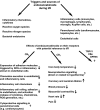Endocannabinoids and cannabinoid receptors in ischaemia-reperfusion injury and preconditioning
- PMID: 18026124
- PMCID: PMC2219536
- DOI: 10.1038/sj.bjp.0707582
Endocannabinoids and cannabinoid receptors in ischaemia-reperfusion injury and preconditioning
Abstract
Ischaemia-reperfusion (I/R) is a pivotal mechanism of organ injury during stroke, myocardial infarction, organ transplantation and vascular surgeries. Ischaemic preconditioning (IPC) is a potent endogenous form of tissue protection against I/R injury. On the one hand, endocannabinoids have been implicated in the protective effects of IPC through cannabinoid CB1/CB2 receptor-dependent and -independent mechanisms. However, there is evidence suggesting that endocannabinoids are overproduced during various forms of I/R, such as myocardial infarction or whole body I/R associated with circulatory shock, and may contribute to the cardiovascular depressive state associated with these pathologies. Previous studies using synthetic CB1 receptor agonists or knockout mice demonstrated CB1 receptor-dependent protection against cerebral I/R injury in various animal models. In contrast, several follow-up reports have shown protection afforded by CB1 receptor antagonists, but not agonists. Excitedly, emerging studies using potent CB2 receptor agonists and/or knockout mice have provided compelling evidence that CB2 receptor activation is protective against myocardial, cerebral and hepatic I/R injuries by decreasing the endothelial cell activation/inflammatory response (for example, expression of adhesion molecules, secretion of chemokines, and so on), and by attenuating the leukocyte chemotaxis, rolling, adhesion to endothelium, activation and transendothelial migration, and interrelated oxidative/nitrosative damage. This review is aimed to discuss the role of endocannabinoids and CB receptors in various forms of I/R injury (myocardial, cerebral, hepatic and circulatory shock) and preconditioning, and to delineate the evidence supporting the therapeutic utility of selective CB2 receptor agonists, which are devoid of psychoactive effects, as a promising new approach to limit I/R-induced tissue damage.
Figures


References
-
- Ashton JC, Rahman RM, Nair SM, Sutherland BA, Glass M, Appleton I. Cerebral hypoxia–ischemia and middle cerebral artery occlusion induce expression of the cannabinoid CB2 receptor in the brain. Neurosci Lett. 2007;412:114–117. - PubMed
-
- Batkai S, Jarai Z, Wagner JA, Goparaju SK, Varga K, Liu J, et al. Endocannabinoids acting at vascular CB1 receptors mediate the vasodilated state in advanced liver cirrhosis. Nat Med. 2001;7:827–832. - PubMed
Publication types
MeSH terms
Substances
Grants and funding
LinkOut - more resources
Full Text Sources
Other Literature Sources

